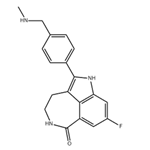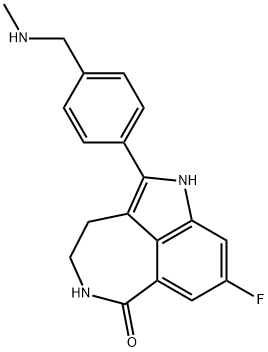Rucaparib: pharmacodynamics, pharmacokinetics and side effects
Nov 24,2023
General Description
Rucaparib is a potent PARP inhibitor with strong inhibitory activity, surpassing other drugs in its class. It effectively accumulates and retains in tumors, leading to sustained inhibition of PARP enzymes. Rucaparib demonstrates significant inhibition of PARP-1 enzyme activity in patients with certain cancers. It exhibits cytotoxic mechanisms in cancer cells, particularly in those with specific gene mutations. Rucaparib also shows synergistic or additive interactions with common chemotherapeutic agents. However, resistance mechanisms and interactions with other signaling pathways may affect its efficacy. In terms of pharmacokinetics, rucaparib has predictable and linear kinetics. Its bioavailability is moderate, and it accumulates at steady state. The drug is primarily metabolized by specific enzymes. Adverse events associated with rucaparib include gastrointestinal symptoms, fatigue, anemia, and laboratory abnormalities. It may also cause embryo-fetal toxicity and QT interval prolongation. Close monitoring is necessary during treatment.

Figure 1. Tablets of rucaparib
Pharmacodynamics
Rucaparib exhibits potent pharmacodynamics as a PARP inhibitor, surpassing olaparib and niraparib in inhibitory activity. In tumor-bearing mice, both oral and intraperitoneal administration of rucaparib led to its accumulation and retention in tumors, effectively inhibiting PARP enzymes for up to 7 days. In patients with metastatic melanoma or advanced ovarian or breast cancer, intravenous or oral rucaparib demonstrated significant inhibition of PARP-1 enzyme activity. While a single oral dose showed substantial inhibition at 24 hours post-administration, a continuous dosing schedule was necessary for sustained inhibition. Furthermore, rucaparib displayed PARP-dependent and -independent cytotoxic mechanisms in cancer cells, proving more cytotoxic than olaparib in vitro. Its efficacy is heightened in cancer cells with mutations in BRCA1/2 genes and other DNA repair genes. Rucaparib also exhibited synergistic or additive interactions with common chemotherapeutic agents, sensitizing cancer cells to various therapies including platinum therapy, chemoradiotherapy, irradiation, and radiopharmaceuticals. However, mechanisms of resistance to rucaparib therapy were identified, including recovery of homologous recombination deficiency (HRD) and defects in non-homologous end joining. Additionally, rucaparib's efficacy may be influenced by its interaction with the phosphatidylinositol 3-kinase (PI3K)/AKT signaling pathway and multidrug efflux transporters. 1
Pharmacokinetics
Rucaparib, a medication used in cancer treatment, exhibits predictable pharmacokinetics in patients with cancer. When administered at doses ranging from 240 to 840 mg twice daily, it demonstrates linear, dose-proportional, and time-independent pharmacokinetics. Following the recommended dosage of 600 mg twice daily, the median time to reach maximal plasma concentration (Tmax) is 1.9 hours. Taking rucaparib with a high-fat meal increases the maximum plasma concentration (Cmax) and the area under the plasma concentration-time curve from 0 to 24 hours (AUC0–24) by 20% and 38%, respectively, while delaying Tmax by 2.5 hours. However, this effect is not considered clinically significant, and thus, rucaparib can be taken with or without food. The immediate-release tablet form of rucaparib has a mean absolute bioavailability of 36%. At steady state, achieved on day 15 of the first cycle, rucaparib accumulates 3.5 to 6.2 times at tested dose levels. Additionally, the medication has a volume of distribution of 113–262 L following a single intravenous dose. In vitro studies show that rucaparib is primarily metabolized by the CYP enzyme CYP2D6, with minor involvement from CYP1A2 and CYP3A4. The drug's mean terminal half-life after a single 600 mg dose ranges from 17 to 19 hours, and its apparent clearance after multiple doses of 600 mg twice daily ranges from 15.3–79.2 L/h. Rucaparib is minimally excreted in urine, with only 11% of the dose recovered within 24 hours. Mild or moderate renal impairment can increase rucaparib exposure by 15% and 32%, respectively, compared to normal renal function, with no marked impact from mild hepatic impairment. The pharmacokinetics of rucaparib in severe renal impairment or moderate to severe hepatic impairment remain unknown. In vitro evaluations indicate that rucaparib interacts with several enzymes and transporters, acting as a substrate and inhibitor for BCRP and P-glycoprotein while impacting various CYP enzymes and transporter proteins. Notably, concomitant administration of rucaparib with proton pump inhibitors does not significantly alter its steady-state exposure. 2
Side effects
Rucaparib, when used as monotherapy at a dosage of 600 mg twice daily, demonstrated manageable tolerability in women with high-grade ovarian cancer. However, it was associated with various treatment-related adverse events. The most common adverse events included nausea (77%), asthenia/fatigue (77%), vomiting (46%), anaemia (44%), constipation (40%), decreased appetite (39%), dysgeusia (39%), diarrhea (34%), abdominal pain (32%), dyspnoea (21%), and thrombocytopenia (21%). Additionally, laboratory abnormalities were observed in more than 35% of patients, such as an increase in creatinine, ALT, AST, or cholesterol, and a decrease in hemoglobin, lymphocytes, platelets, or neutrophils. Notably, myelodysplastic syndrome/acute myeloid leukemia were reported in less than 1% of patients. Furthermore, due to its mechanism of action and data from animal studies, rucaparib has the potential to cause embryo-fetal toxicity, necessitating contraception in women of reproductive potential during and up to 6 months after treatment. Additionally, close monitoring for hematological toxicity is recommended at baseline and monthly thereafter. It's also important to note that rucaparib can increase Fridericia’s formula-corrected QT interval from baseline by a mean of 14.9 ms in patients with solid tumors at steady state. 3
Reference
1. Ihnen M, Zu Eulenburg C, Kolarova T, et al Therapeutic potential of the poly(ADP-ribose) polymerase inhibitor rucaparib for the treatment of sporadic human ovarian cancer. Mol Cancer Ther. 2013;12(6):1002–1015.
2. Clovis Oncology Inc. Prescribing information for RubracaTM (rucaparib) tablets, for oral use. 2016. https://www.fda.gov. Accessed 9 Jan 2017.
3. Syed YY. Rucaparib: First Global Approval. Drugs. 2017 Apr;77(5):585-592.
- Related articles
- Related Qustion
Ninhydrin hydrate's accidental discovery led to its applications in detecting primary amino groups and developing fingerprints.....
Nov 24,2023APIEleutheroside A from Eleutherococcus senticosus shows promise in cancer, colitis, and liver disease treatment, but requires further toxicity research.....
Nov 24,2023APIRucaparib
283173-50-2You may like
- Rucaparib
-

- $0.00 / 1kg
- 2022-10-01
- CAS:283173-50-2
- Min. Order: 1kg
- Purity: 98%
- Supply Ability: 1Ton
- Rucaparib
-

- $15.00 / 1KG
- 2021-07-13
- CAS:283173-50-2
- Min. Order: 1KG
- Purity: 99%+ HPLC
- Supply Ability: Monthly supply of 1 ton
- Rucaparib
-

- $15.00 / 1KG
- 2021-07-09
- CAS:283173-50-2
- Min. Order: 1KG
- Purity: 99%+ HPLC
- Supply Ability: Monthly supply of 1 ton




